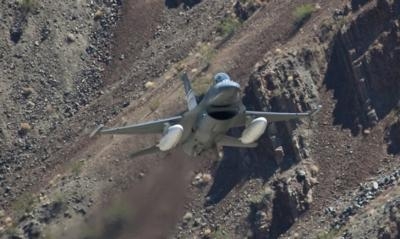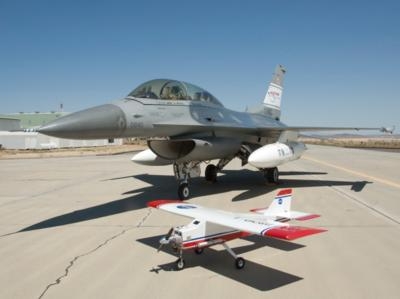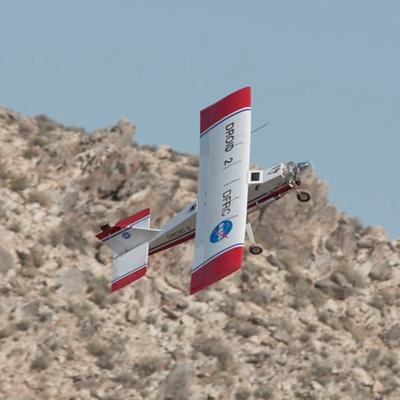Currently Being Integrated Into USAF F-16 Airplanes
A new NASA-developed Automatic Ground-Collision Avoidance System (Auto-GCAS) that could significantly reduce the incidence of controlled flight into terrain aircraft accidents is currently being integrated into the flight control systems of the U.S. Air Force's fleet of F-16 fighter aircraft.

The new software, pioneered at NASA's Armstrong Flight Research Center at Edwards, California, in partnership with the Office of the Undersecretary for Personnel and Readiness, the Air Force Research Laboratory (AFRL), the Air Force Test Center (AFTC) and Lockheed Martin, is expected to have application to a wide variety of civil and military aircraft.
Extensive flight-testing at NASA Armstrong demonstrated that advanced computing technology could significantly reduce the number of accidents attributed to controlled flight into terrain (CFIT), a leading cause of fatalities in both civil and military aviation that results in roughly 100 deaths each year in the United States alone. Although cockpit-warning systems have virtually eliminated CFIT for large commercial air carriers, the problem still remains for fighter aircraft, helicopters, and general aviation.
Application of Auto-GCAS into the F-16 fleet is a response to the significant number of mishaps resulting from distracted or incapacitated pilots flying into the ground in an otherwise fully functioning aircraft. Components of the F-16 Auto-GCAS include modifications to the airplane’s digital flight-control computer, advanced data-transfer equipment, and modified mission computer software. As the airplane approaches the ground, the computer determines how much time remains before impact, and then triggers an autopilot-commanded maneuver to avoid a crash.
NASA has been jointly developing automatic collision avoidance technologies with the Air Force for nearly three decades, according to Mark Skoog, NASA’s principal investigator for the project.
“Development of Auto-GCAS began as a reimbursable project between Armstrong and AFRL back in the mid-1980s,” Skoog said.
Technology refinements took place in 1997 and 1998 under a "full-envelope" Auto-GCAS research project in the final stages of the Advanced Fighter Technology Integration F-16 program. The team conducted more than 556 test maneuvers during 49 flights, some of which involved diving at the ground and toward the sides of mountains. Key objectives included demonstrating that Auto-GCAS could significantly reduce the number of mishaps resulting from pilot spatial disorientation, loss of situational awareness, gravity-induced loss of consciousness, and landing-gear-up landings. The research also focused on identifying any instances where Auto-GCAS might impede a pilot's performance on standard tactical missions.
The next phase of the project, known as Automatic Collision Avoidance Technology (ACAT), began in the late 2000s as a broad-based program to enhance and transition automatic collision avoidance technologies throughout the aviation industry, starting with the Department of Defense. An Air Force F-16D was selected as a test platform.

“We conducted a risk reduction program under AFRL, then the work and the jet moved down the street to the AFTC where final production integration was accomplished,” Skoog noted.
Flight-testing began in 2009 with NASA Armstrong leading the project's integrated test team. Additionally, NASA was responsible for the technical direction, maintenance of the test aircraft, project management and engineering services. Armstrong also provided the project's chief research pilot, Nils Larson. Following completion of flight research in August 2010, the project transitioned to the AFTC’s 416th Flight Test Squadron for production testing of the Auto-GCAS software.
Researchers quickly realized that when fully developed and matured, miniaturized Auto-GCAS technology had numerous potential civil and military applications for both crewed and remotely piloted unmanned aircraft. In 2012, project officials at Armstrong adapted Auto-GCAS to a small, unmanned research aircraft and implemented it as a smartphone application using the Android operating system linked to the aircraft’s Piccolo autopilot.
This system was installed in a Dryden Remotely Operated Integrated Drone (DROID) and flown from a remote dry lakebed surrounded by rugged desert terrain. Throughout the test series, the smartphone-assisted autopilot repeatedly executed pull-ups or sharp turns to avoid imminent impact with terrain in the DROID’s flight path.
"The smartphone aboard the aircraft eliminated the need for the ground control station link to be in constant communication with the aircraft," said Skoog. "On these flights the system performed very reliably, consistently initiating recoveries close to the last possible moment, even in the face of numerous losses of communications with the ground control station [including those] right at the critical point of needing to avoid the colliding with the mountain."
Air Force officials announced in 2013 that an operational Auto-GCAS system would be installed in the F-16 fleet, and that similar systems would be developed for use in the F-22 and F-35. Future NASA research with smartphone-augmented unmanned aircraft may have significant applications in developing sense-and-avoid technology for civil aviation and remotely piloted or autonomous aircraft sharing the National Airspace System.

“There are efforts underway for adapting this capability to rotorcraft as part of a larger framework for developing full vehicle autonomy,” Skoog added.
Expanding on previous work, researchers at Armstrong are also developing an improved ground-collision avoidance system that offers higher fidelity terrain mapping, enhanced vehicle performance modeling, multidirectional avoidance techniques, more efficient data-handling methods and user-friendly warning systems. The algorithms in Armstrong’s technology have also been incorporated into an application for tablet or other handheld/mobile computing devices that will enable pilots to have access to this lifesaving safety tool regardless of what type of aircraft they are flying. The system also can be incorporated into electronic flight bags and / or aircraft avionics systems.
The payoff from implementing this technology, designed to operate with only minimal aircraft modifications, could result in billions of dollars and hundreds of lives and aircraft being saved. Furthermore, the technology has the potential to be applied beyond aviation and could be adapted for use in any vehicle that has to avoid a collision threat, including automobiles, spacecraft, and marine systems.
(Pictured Top: The Air Force F-16D Automatic Collision Avoidance Technology test aircraft flew at low levels through canyons and past mountain peaks during ACAT Fighter Risk Reduction Project testing of collision avoidance technologies that would reduce the risk of ground collisions for fighter/attack aircraft. Middle: The modified "DROID" small unmanned aircraft in the foreground was used as a test bed for development of a smartphone-enabled autonomous ground collision avoidance system adapted from the Auto-GCAS software that was successfully flight-tested at NASA Dryden on the F-16D behind it in 2010. Bottom: NASA Dryden's DROID research aircraft executes a hard right climbing turn to avoid crashing into a rocky desert ridge during tests of a miniaturized automatic ground collision avoidance system for small, unmanned air vehicles. The system was installed in a smartphone connected to its autopilot)
 Airborne 11.05.25: Tesla Flying Car?, Jepp/ForeFlight Sold, A220 Troubles
Airborne 11.05.25: Tesla Flying Car?, Jepp/ForeFlight Sold, A220 Troubles Airborne 11.07.25: Affordable Expo Starts!, Duffy Worries, Isaacman!
Airborne 11.07.25: Affordable Expo Starts!, Duffy Worries, Isaacman! Aero-News: Quote of the Day (11.05.25)
Aero-News: Quote of the Day (11.05.25) ANN's Daily Aero-Linx (11.05.25)
ANN's Daily Aero-Linx (11.05.25) NTSB Prelim: Cirrus Design Corp SR22
NTSB Prelim: Cirrus Design Corp SR22





